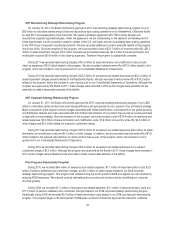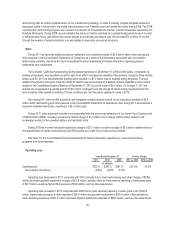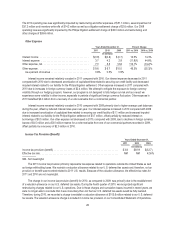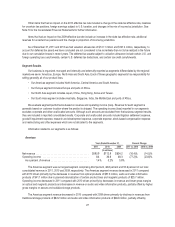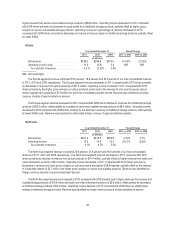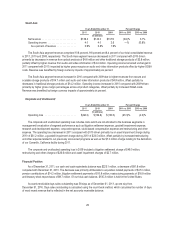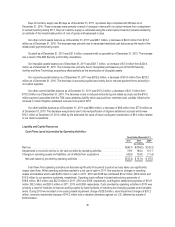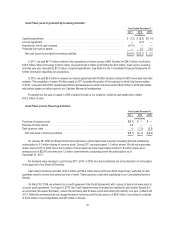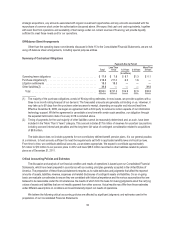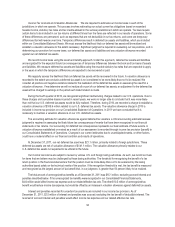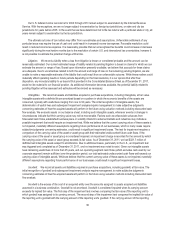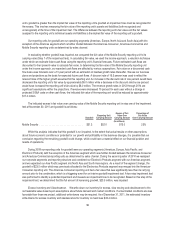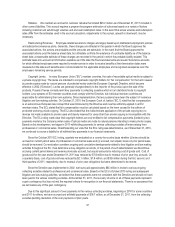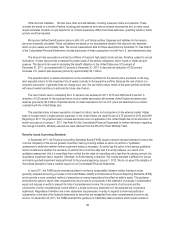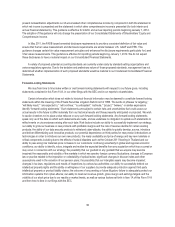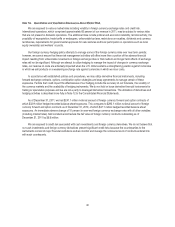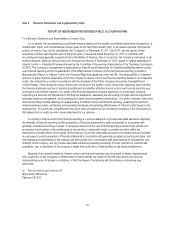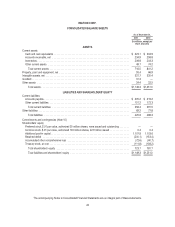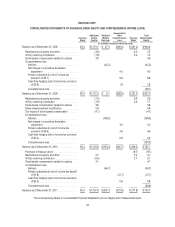Memorex 2011 Annual Report Download - page 37
Download and view the complete annual report
Please find page 37 of the 2011 Memorex annual report below. You can navigate through the pages in the report by either clicking on the pages listed below, or by using the keyword search tool below to find specific information within the annual report.Income Tax Accruals and Valuation Allowances. We are required to estimate our income taxes in each of the
jurisdictions in which we operate. This process involves estimating our actual current tax obligations based on expected
taxable income, statutory tax rates and tax credits allowed in the various jurisdictions in which we operate. Tax laws require
certain items to be included in our tax returns at different times than the items are reflected in our results of operations. Some
of these differences are permanent, such as expenses that are not deductible in our tax returns, and some are temporary
differences that will reverse over time. Temporary differences result in deferred tax assets and liabilities, which are included
within our Consolidated Balance Sheets. We must assess the likelihood that our deferred tax assets will be realized and
establish a valuation allowance to the extent necessary. Significant judgment is required in evaluating our tax positions, and in
determining our provision for income taxes, our deferred tax assets and liabilities and any valuation allowance recorded
against our net deferred tax assets.
We record income taxes using the asset and liability approach. Under this approach, deferred tax assets and liabilities
are recognized for the expected future tax consequences of temporary differences between the book and tax basis of assets
and liabilities. We measure deferred tax assets and liabilities using the enacted statutory tax rates that are expected to apply
in the years in which the temporary differences are expected to be recovered or paid.
We regularly assess the likelihood that our deferred tax assets will be recovered in the future. A valuation allowance is
recorded to the extent we conclude a deferred tax asset is not considered to be more-likely-than-not to be realized. We
consider all positive and negative evidence related to the realization of the deferred tax assets in assessing the need for a
valuation allowance. If we determine we will not realize all or part of our deferred tax assets, an adjustment to the deferred tax
asset will be charged to earnings in the period such determination is made.
During the fourth quarter of 2010, we recognized significant restructuring charges related to our U.S. operations. Due to
these charges and cumulative losses incurred in recent years, we were no longer able to conclude that it was more-likely-
than-not that our U.S. deferred tax assets would be fully realized. Therefore, during 2010, we recorded a charge to establish a
valuation allowance of $105.6 million related to our U.S. deferred tax assets. The valuation allowance charge in 2010 is
included in income tax provision on our Consolidated Statement of Operations. In 2011 we have concluded that it is
necessary to maintain a valuation allowance on our U.S. deferred tax assets.
The accounting estimate for valuation allowances against deferred tax assets is a critical accounting estimate because
judgment is required in assessing the likely future tax consequences of events that have been recognized in our financial
statements or tax returns. Our accounting for deferred tax consequences represents our best estimate of future events. A
valuation allowance established or revised as a result of our assessment is recorded through income tax provision (benefit) in
our Consolidated Statements of Operations. Changes in our current estimates due to unanticipated events, or other factors,
could have a material effect on our financial condition and results of operations.
At December 31, 2011, our net deferred tax asset was $21.1 million, primarily related to foreign jurisdictions. These
deferred tax assets are net of valuation allowance of $141.1 million. The valuation allowance primarily relates to our
U.S. deferred tax assets not expected to be utilized in the future.
Our income tax returns are subject to review by various U.S. and foreign taxing authorities. As such, we record accruals
for items that we believe may be challenged by these taxing authorities. The threshold for recognizing the benefit of a tax
return position in the financial statements is that the position must be more-likely-than-not to be sustained by the taxing
authorities based solely on the technical merits of the position. If the recognition threshold is met, the tax benefit is measured
and recognized as the largest amount of tax benefit that, in our judgment, is greater than 50 percent likely to be realized.
The total amount of unrecognized tax benefits as of December 31, 2011 was $15.1 million, excluding accrued interest and
penalties described below. If the unrecognized tax benefits were recognized in our Consolidated Financial Statements,
$4.6 million would affect income tax expense and our related effective tax rate. The other $10.5 million of unrecognized tax
benefit would reduce income tax expense, but would be offset by an increase in valuation allowance against deferred tax assets.
Interest and penalties recorded for uncertain tax positions are included in our income tax provision. As of
December 31, 2011, $2.5 million of interest and penalties was accrued, excluding the tax benefit of deductible interest. The
reversal of accrued interest and penalties would affect income tax expense and our related effective tax rate.
34


